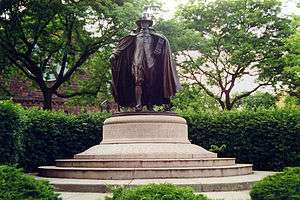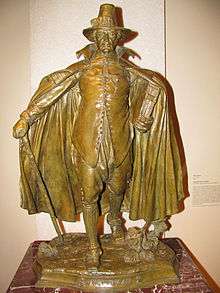The Puritan (Springfield, Massachusetts)

The Puritan is a bronze statue by sculptor Augustus St. Gaudens in Springfield, Massachusetts, United States, which later became so popular that it was reproduced for over 20 other cities, museums, universities, and private collectors around the world. Augustus Saint-Gaudens was one of the most influential and successful artists of the late 19th century.
History

In 1881, Chester W. Chapin, a railroad tycoon and congressman from Springfield, Massachusetts, commissioned[1] the renowned sculptor Augustus Saint-Gaudens to create a bronze likeness of his ancestor, Deacon Samuel Chapin (1595–1675), one of the early settlers of the City of Springfield.[2] By 1881, Springfield had become one of America's most innovative industrial and manufacturing centers, and was one of the wealthiest cities in the United States.
The sculpture, cast at the Bureau Brothers Foundry in Philadelphia,[3] was unveiled on November 24, 1887 in Stearns Square, between Bridge Street and Worthington Street - a collaboration between the artistic "dream team" of Stanford White (of the renowned architecture firm McKim, Mead, and White) and Saint-Gaudens - and featured numerous sculptural and landscape architectural details to enhance the sculpture. In 1899 the statue was moved to Merrick Park, on the corner of Chestnut and State Streets, one of Springfield's most important intersections (now part of the Quadrangle cultural center). It has remained there ever since.[4]
This impressive sculpture of the The Deacon can be found next to the palatial Springfield City Library. The base is inscribed: "1595 Anno Domini 1675 Deacon Samuel Chapin One Of The Founders Of Springfield"

Popularity
The statue was so popular with the public that Saint-Gaudens decided to produce smaller scale versions of this work under the title The Puritan. He correctly surmised that this would be an excellent source of addition income. Today more than 25 slightly altered copies of this work can be found in museums, art galleries, universities, and private collections around the world.[5] For example, a copy of The Puritan remains on display in gallery 767 of New York City's Metropolitan Museum of Art.[6]
The New England Society of Pennsylvanians asked Gaudens to make a replica of The Puritan for the city of Philadelphia, Pennsylvania. For the later commission Gaudens made some changes in the figure's dress and adjusted the facial characteristics to represent a New England type: "For the head in the original statue, I used as a model the head of Mr. Chapin himself, assuming that there would be some family resemblance with the Deacon, who was his direct ancestor. But Mr. Chapin's face is round and Gaelic in character, so in the Philadelphia work, I changed the features completely, giving them the long, New England type, besides altering the folds of the cloak in many respects, the legs, the left hand, and the Bible." The Pilgrim was originally placed on the South Plaza of City Hall but was relocated to its present site in Fairmount Park in 1920.[7]
References
- Bach, Penny Balkin. Public Art in Philadelphia Temple University Press, 1992. Philadelphia PA.
- Burt, Henry M. The First Century of the History of Springfield: the Official Records from 1636 to 1736, with an Historical Review and a Biographical Mention of the Founders, Volume I Henry M. Burt, 1898. Springfield MA. full text online
- Dryfhout, John H. The Work of Augustus Saint-Gaudens University Press of New England, 1982. Lebanon NH.
- Metropolitan Museum of Art, The. "Heilbrunn Timeline of Art History". Metropolitan Museum of Art, 2000. New York NY.
- Tolles, Thayer. "Augustus Saint-Gaudens in The Metropolitan Museum of Art." The Metropolitan Museum of Art Bulletin, v. 66, no. 4 (Spring, 2009). New York NY.
Notes
External links
- Metropolitan Museum of Art Discussion of the sculpture's history.
- Augustus Saint-Gaudens, Master Sculptor, exhibition catalog fully online as PDF from The Metropolitan Museum of Art, which contains material on The Puritan
Coordinates: 42°06′11″N 72°35′07″W / 42.10306°N 72.58527°W